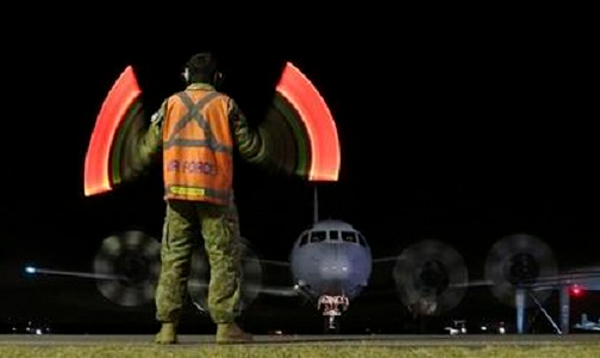No objects from search linked yet to Flight 370
PERTH, Australia (AP) — Despite what Australia called an “intensifying search effort,” an international hunt Sunday by aircraft and ships in the southern Indian Ocean found no debris linked to the Malaysian jet that vanished more than three weeks ago.
Several dozen angry Chinese relatives of Flight 370 passengers demanded “evidence, truth, dignity” from Malaysian authorities, expressing their frustrations at a hotel near Kuala Lumpur as the mystery drags on.
Nine aircraft and eight ships searching the waters off western Australia found only “fishing equipment and other flotsam” not connected to the Malaysia Airlines plane, the Australian Maritime Safety Authority said. The Boeing 777 disappeared March 8 while flying from Kuala Lumpur to Beijing with 239 people aboard.
But at least four orange objects that were more than 2 metres (6 feet) in size were seen by the crew of an Australian P3 Orion search plane, said the pilot, Flight Lt Russell Adams, after returning to base.
“I must stress that we can’t confirm the origin of these objects,” he said, adding that images of the items have yet to be verified, and a GPS buoy was dropped and ships must still investigate.
Adams said it was “the most visibility we had of any objects in the water and gave us the most promising leads.”
The planes and ships are scouring a search zone that was redefined Friday based on satellite data from the Boeing 777, but they have found no debris associated with the flight, said Australian Navy Commodore Peter Leavy. The zone lies in a shipping lane where sea trash is common, complicating the effort.
Australian Prime Minister Tony Abbott insisted the “intensifying search effort” was positive because objects “have been recovered from the ocean” in the zone after a weeklong search in another area saw items from planes that ships never managed to find.
The planes taking part in Sunday’s search included three Australian P3 Orions, a Japanese P3, a Chinese Il-76, a Korean Orion, a US Poseidon, and two Malaysian C-130s.
Eight ships were on the scene, an area roughly the size of Poland or New Mexico, about 1,850 kilometres (1,150 miles) west of Australia. The vessels include the Australian navy supply ship HMAS Success, which was designated to carry any wreckage found.
Abbott said a former Australian defence chief, Air Chief Marshal Angus Houston, will head a new centre in Perth for search and recovery operations, coordinating the international effort.
Searchers were hampered by rain and low clouds, but still were able to look for debris because of visibility of about 10 kilometres (6 miles). It takes planes about 2 1/2 hours to get to the area, allowing a five-hour search before they must return.
Other objects spotted so far include three with white, red and orange colors by the Chinese plane, China’s official Xinhua News Agency said. The missing Boeing 777’s exterior was red, white, blue and gray.
For a full week, searchers relied on satellite imagery from various countries as they tried to find the plane in a zone to the south of the current area. They abruptly shifted the site Friday after authorities concluded the plane could not have travelled as far as they had thought based on its estimated speed and fuel consumption.
That prompted the change in the search for the plane’s likely entry point into the sea and the possible location of its flight recorders, or “black boxes,” which should contain clues to what caused the aircraft to fly so far off-course.
The Ocean Shield, an Australian warship with a US device that detects “pings” from the flight recorders was joining the search. It will still take three to four days for the Ocean Shield to reach the search zone.
“The ship will take part in the surface search until the debris is positively identified and an underwater search area is then predicted,” US Navy Captain Mark Matthews said.
In addition to the ping locator, the ship will also have an unmanned underwater vehicle and other equipment to look for wreckage on the seabed.
The search area is so big that investigators are first hoping to find floating debris so they could set a smaller zone using sophisticated analysis to determine a location from where the pieces drifted. Even if they do that, recovering the flight recorders could be complicated.
Despite the huge area, one advantage is the seabed of the search zone is generally flat, with the exception of a steep slope and a deep trench near its southern end.
The area is dominated by a muddy ocean floor known as Broken Ridge, which is actually a plateau where depths range from as shallow as about 800 metres (2,625 feet) to about 3,000 metres (9,843 feet).

